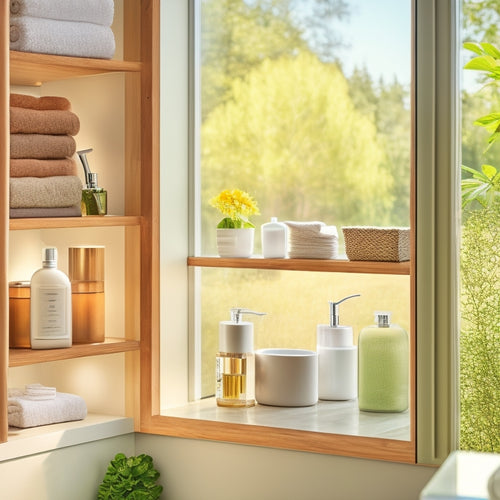
What's Hiding in Your Cluttered Bathroom Cabinets?
Share
You're likely hiding more than just toiletries in your cluttered bathroom cabinets. Expired medications that can be ineffective or toxic, rusty razors and broken appliances that can cause physical harm, and a culture medium for mold growth are all lurking in the shadows. These hidden dangers can pose serious threats to your health and safety. But it's not all doom and gloom - by organizing your space and purging expired products, you can create a safer, more efficient bathroom. Take the first step towards a more streamlined morning routine and discover the secrets to maximizing your bathroom's storage potential.
Key Takeaways
• Expired medications, rusty razors, and broken appliances pose hidden threats in cluttered bathroom cabinets.
• Cluttered cabinets create an ideal environment for mold growth and disorganization can lead to safety hazards like tripping.
• Hidden dangers in cluttered cabinets can cause physical harm, ineffective or toxic medications, and physical harm from rusty razors and broken appliances.
• Cluttered cabinets can hide expired products, broken items, and unhygienic conditions that negatively impact daily routines and overall well-being.
• A cluttered bathroom cabinet can lead to decreased productivity, increased stress, and wasted time searching for essential items.
Hidden Dangers of Cluttered Cabinets
Lurking behind the closed doors of your bathroom cabinets, expired medications, rusty razors, and broken appliances pose hidden threats to your health and safety. You mightn't think twice about storing these items, but they can have devastating consequences if not addressed.
Expired medications, for instance, can be ineffective or even toxic, putting you at risk of adverse reactions. Rusty razors and broken appliances, on the other hand, can cause physical harm, leading to cuts, electrical shocks, or even fires.
Moreover, cluttered cabinets create an ideal environment for mold growth, which can exacerbate respiratory issues like asthma. The moisture-rich bathroom environment, combined with poor ventilation, allows mold to thrive, putting your health at risk.
Additionally, the disorganization can lead to safety hazards, such as tripping over clutter or knocking over heavy objects. It's vital to take control of your bathroom cabinets, purge the expired and broken items, and create a safe and organized space that promotes your well-being. By doing so, you'll be taking an important step towards a healthier, safer you.
Maximizing Bathroom Storage Space
By evaluating your bathroom's unique dimensions and storage needs, you can create a tailored system that maximizes every available inch of space. This is essential in creating a functional and organized bathroom.
To achieve this, divide your bathroom into zones, each catering to a specific function, such as a skincare zone or a haircare zone. This will help you allocate storage space efficiently.
Here are some storage hacks to get you started:
-
Install a recessed medicine cabinet to store small items like cotton balls and Q-tips.
-
Use adhesive-backed hooks to hang items like towels, robes, or bags.
-
Invest in a pedestal sink organizer to store essentials like toothbrushes and toothpaste.
- Utilize the space above your toilet by installing a storage cabinet or shelves.
Decluttering Bathroom Essentials
When you start decluttering your bathroom essentials, it's crucial to be ruthless about what you really need.
You'll want to identify the must-haves, get rid of expired products, and categorize items to create a functional and peaceful space.
Essential Items Only
Sort through your bathroom cabinets and identify the essential items you use daily, such as toothbrush, toothpaste, and any necessary medications, to create a solid foundation for your decluttering process. These must-haves are the cornerstone of your bathroom routine, and focusing on them first will help you prioritize what stays and what goes.
Here are the essentials to get you started:
-
Toothbrush and toothpaste: The dynamic duo of oral hygiene
-
Deodorant: Your trusty sidekick for fresh confidence
-
Shampoo and conditioner: For a hair-raising experience
- Moisturizer: Your skin's BFF for hydration and glow
Consider your personal preferences and product favorites when selecting the essentials. Do you have a go-to shampoo or a holy-grail moisturizer? Keep those, and let go of the rest.
Purge Expired Products Now
Purge expired products now, and give your bathroom cabinets a fresh start by tackling the culprit of clutter: outdated items that no longer serve a purpose. It's time to get ruthless – if a product has expired, it's no longer effective, and it's taking up valuable space in your cabinet. Check the product labels for expiration dates, and be honest with yourself: when was the last time you used that skincare haul you bought on a whim?
Take everything out of your cabinets and sort items into three piles: keep, donate/sell, and toss. Be merciless – if you haven't used it in the past year, it's probably safe to get rid of it. Don't hold onto items just because they were expensive or you feel guilty about wasting money.
Organize by Category
Now that you've purged your expired products, categorize the remaining items into groups, like skincare, haircare, and oral care, to create a sense of control and visibility in your bathroom cabinets. This step is important in maximizing your bathroom's storage potential.
By organizing by category, you'll be able to see what you have, where it's located, and what you need to restock.
Here are some benefits of categorizing your bathroom essentials:
-
Streamlined routines: With similar products grouped together, you'll save time getting ready in the morning.
-
Easy inventory management: You'll quickly identify what's running low and what's expired.
-
Reduced clutter: By assigning a home for each category, you'll prevent clutter from building up in the future.
- Customized storage: You can create personalized zones within your cabinets, making the most of your storage space.
Customizing Cabinet Storage Solutions
You can design a customized storage system by evaluating your bathroom cabinet's dimensions and identifying the items you need to store. By doing so, you can maximize the space and create a more organized and efficient storage solution.
To get started, consider the following storage solutions:
| Storage Solution | Benefits |
| Adjustable Shelves | Provides flexibility to accommodate items of varying sizes, allowing for easy rearrangement as your storage needs change. |
| Corner Carousels | Makes the most of the often-wasted space in corner cabinets, providing easy access to items that would otherwise be hard to reach. |
| Tiered Baskets | Offers a convenient way to separate and store small items, keeping them organized and within easy reach. |
Utilizing Vertical Storage Options
By installing shelves, hooks, or a pegboard on the back of a cabinet door or wall, you can capitalize on the often-underutilized vertical space in your bathroom, freeing up valuable floor and shelf space for other essentials. This is especially useful for storing items that you don't use frequently, such as seasonal decorations or extra toilet paper rolls.
Here are some ways to maximize your bathroom's vertical storage:
-
Install stackable shelves to store towels, toiletries, or cleaning supplies
-
Hang organizers like baskets or bins to store small items like Q-tips, cotton balls, or bobby pins
-
Use adhesive hooks to hang items like robes, towels, or bags
- Incorporate a pegboard with hooks and bins to store items like hair accessories, jewelry, or makeup brushes
Streamlining Morning Routines
With your bathroom's vertical storage maximized, you can focus on streamlining your morning routines, starting with the essentials: a well-organized countertop and a thoughtfully planned daily regimen. You'll be amazed at how a clutter-free space can boost your morning mindset and set you up for success.
Begin by grouping similar products together, such as skincare, haircare, and makeup, and designate a specific spot for each item. This will save you time and reduce decision fatigue.
Next, prioritize your daily tasks and allocate specific time slots for each activity. This will help you establish productive habits and create a sense of control over your morning routine. Consider implementing a 'launching pad' near the bathroom door, where you can place essential items like your wallet, keys, and phone.
Frequently Asked Questions
How Often Should I Clean My Bathroom Cabinets to Prevent Clutter Buildup?
You should clean your bathroom cabinets every 1-2 months to prevent clutter buildup, maintaining a daily routine to put back items, and monitoring your clutter threshold to avoid hidden hazards and forgotten items.
Can I Use Adhesive Hooks to Hang Items on the Back of Cabinet Doors?
You can cleverly create convenient door organization by using adhesive hooks to hang items on the back of cabinet doors, cleverly concealing clutter and creating hidden storage, keeping your bathroom tidy and organized.
Are There Any Eco-Friendly Alternatives to Traditional Bathroom Cleaning Products?
You can switch to eco-friendly cleaning products by opting for natural soaps and checking for eco labels like EcoLogo or Safer Choice, ensuring a healthier home and planet, while still getting the job done effectively.
Can I Store Medications in the Bathroom or Is It Too Humid?
Did you know 25% of meds are expired or spoiled? You shouldn't store meds in the bathroom due to humidity; it can affect medicine expiration. Invest in humidity control measures, like a dehumidifier, to maintain ideal storage conditions.
How Do I Prevent Moisture Buildup in Cabinets to Avoid Mold Growth?
To prevent moisture buildup in cabinets, you'll want to use humidity absorbers and promote good air circulation by leaving a small gap between shelves and keeping cabinet doors slightly ajar, reducing mold growth risks.
Related Posts
-

Modular Storage for Bathroom Decluttering
Modular storage is your solution for effective bathroom decluttering. It maximizes every inch of space, allowing cust...
-

Mastering Project Management Organization for Success
You know that mastering project management organization is essential for success, but it requires a strategic approac...
-

Planner Preferences Spark Paper Vs. Digital Debate
The debate between paper and digital planners has ignited a passionate discussion among planner enthusiasts, with eac...


